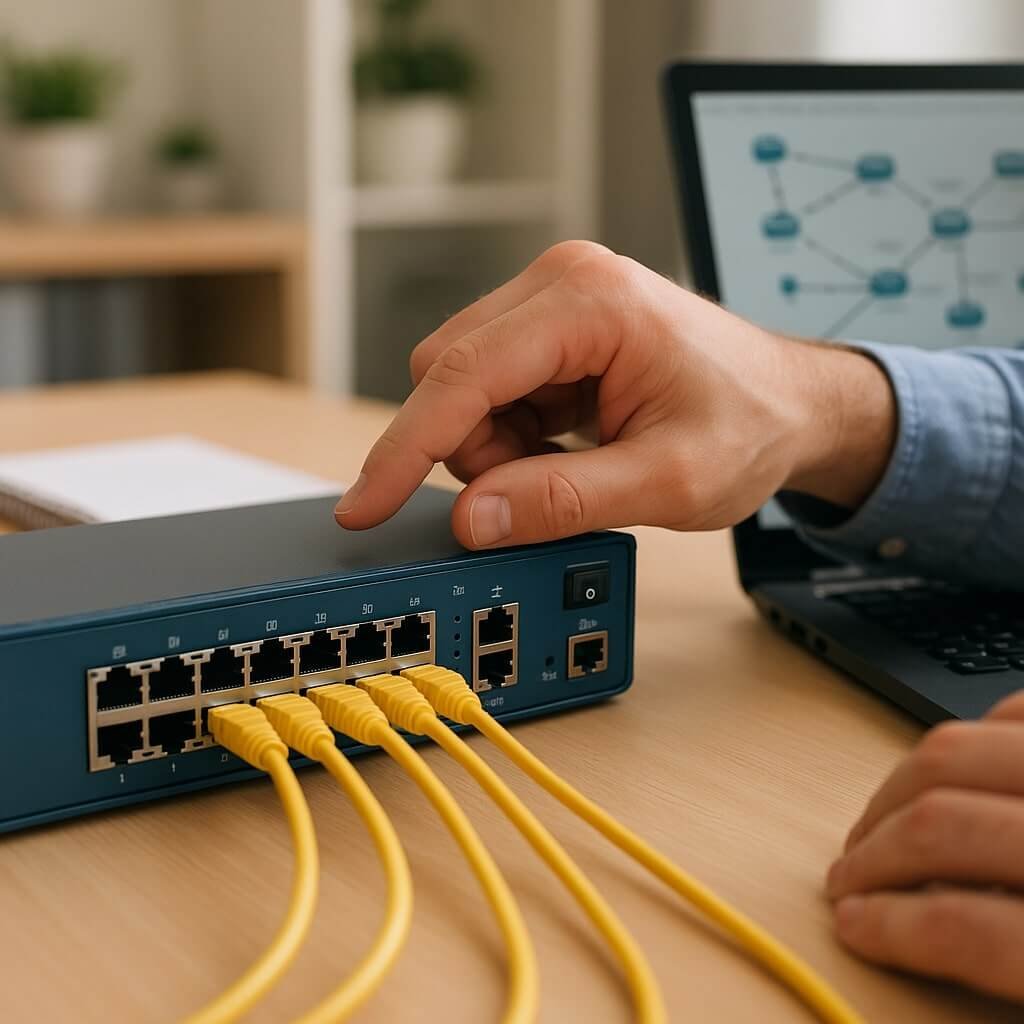Securing your wireless network is essential in today’s digital landscape. By implementing effective strategies, you can greatly reduce vulnerabilities that expose your network to unauthorized access. From changing default settings to enabling advanced encryption protocols, each method plays an important role in fortifying your network. Understanding these techniques can help you stay one step ahead of potential threats. What specific steps are you currently taking to enhance your wireless security?
Key Takeaways
- Change default SSID names and passwords to obscure router details and enhance security through unique identifiers.
- Enable WPA3 encryption for stronger protection against attacks and disable WPS to mitigate vulnerabilities.
- Use complex Wi-Fi passwords of 12-16 characters and regularly update firmware for enhanced security and performance.
- Activate network firewalls to monitor traffic and implement short DHCP lease times to quickly detect unauthorized devices.
- Employ MAC address filtering for device access control and regularly review connected devices for unusual activity.
Change Default Network Names and Passwords
When setting up your wireless network, changing the default network names (SSID) and passwords is essential for enhancing security. Default SSIDs often reveal your router’s make and model, making it easier for attackers to exploit vulnerabilities. By customizing your network naming, you obscure this information, adding a layer of protection.
Additionally, opt for a strong password that includes a mix of upper and lower-case letters, numbers, and symbols. This greatly improves password strength, making it harder for unauthorized users to gain access. Avoid using easily guessed information, such as birthdays or common phrases.
Regularly updating your SSID and password further fortifies your network, reducing the risk of cyber threats and ensuring a secure online environment.
Enable WPA3 Encryption
To enhance your wireless network security, enabling WPA3 encryption is essential, especially as cyber threats continue to evolve.
WPA3 offers significant benefits over its predecessor, including improved protection against brute-force attacks and enhanced security for open networks through Opportunistic Wireless Encryption (OWE).
When you implement WPA3, you’ll utilize Simultaneous Authentication of Equals (SAE), which strengthens password-based authentication by preventing eavesdropping and guaranteeing unique session keys.
Additionally, WPA3 supports Forward Secrecy, meaning that even if a session key is compromised, past sessions remain secure.
To implement WPA3, verify your router’s firmware is updated and confirm that your devices support this protocol.
This upgrade is a proactive step toward safeguarding your network against emerging threats.
Disable WPS (Wi-Fi Protected Setup)
Disabling WPS is essential due to its known vulnerabilities that can compromise your network security.
By opting for manual connection methods, you enhance control over your devices and reduce the risk of unauthorized access.
Additionally, exploring alternative setup methods provides a more secure approach to connecting devices without relying on WPS.
Understanding WPS Vulnerabilities
Although WPS (Wi-Fi Protected Setup) was designed to simplify the process of connecting devices to a wireless network, it harbors significant vulnerabilities that can compromise network security.
Understanding these WPS security risks is essential for protecting your network.
- WPS PIN vulnerabilities: The eight-digit PIN is susceptible to brute-force attacks, allowing unauthorized access.
- WPS protocol weaknesses: Flaws in the WPS protocol can be exploited, leading to unauthorized connections.
- WPS enforcement issues: Weak enforcement of security standards across devices can create exploitable gaps.
Manual Connection Advantages
Opting for manual connection methods eliminates the security risks associated with WPS. By disabling WPS, you gain significant manual connection benefits, enhancing your network’s security posture.
Manual connections require users to enter a complex password, which minimizes the likelihood of unauthorized access. This process grants you greater user control over who connects to your network, as it necessitates proactive engagement rather than relying on automated systems that can be exploited.
Additionally, manual connections reduce the attack surface; since there’s no push-button method available, potential intruders face increased difficulty in gaining entry. Ultimately, choosing manual connections not only fortifies your network security but also empowers you to maintain tighter control over your wireless environment.
Alternative Setup Methods
When you disable WPS (Wi-Fi Protected Setup), you greatly reduce the risk of unauthorized access to your wireless network.
WPS is known for its vulnerabilities, making it a target for attackers. By disabling it, you enhance your network’s overall security.
Here are three alternative setup methods to evaluate:
- Manual Configuration: Set up your network manually using strong, complex passwords that are difficult to guess.
- Wireless Isolation: Enable wireless isolation to prevent devices on your network from communicating with each other, limiting potential intrusions.
- Guest Networks: Create a separate guest network for visitors, ensuring they don’t access your primary network’s resources.
Implementing these strategies can considerably bolster your wireless network security.
Use a Strong Wi-Fi Password
To secure your wireless network, it’s crucial to implement password complexity requirements, ensuring your Wi-Fi password includes a mix of letters, numbers, and special characters.
Regularly updating this password not only mitigates risks from potential breaches but also keeps unauthorized users at bay.
Password Complexity Requirements
A strong Wi-Fi password is essential for safeguarding your network, as it serves as the first line of defense against unauthorized access.
To guarantee peak password strength, consider implementing the following password policies:
- Length: Your password should be at least 12-16 characters long to increase complexity and deter brute-force attacks.
- Character Variety: Incorporate uppercase letters, lowercase letters, numbers, and special characters to enhance unpredictability.
- Avoid Common Patterns: Steer clear of easily guessable information, such as birthdays or common phrases, to reduce vulnerability.
Regular Password Updates
Using a strong Wi-Fi password is only part of an effective security strategy; regular password updates are equally important in maintaining network integrity.
Implementing password rotation as a security policy helps mitigate risks associated with unauthorized access. By changing your password every few months, you reduce the likelihood of potential breaches stemming from compromised credentials.
It’s essential to establish a routine that aligns with your organization’s security policies, ensuring that all users are educated on the importance of these updates.
Regularly revisiting your password complexity requirements enhances overall security, as it prompts you to create unique and robust passwords.
In doing so, you not only safeguard your network but also foster a culture of vigilance among users.
Enable Network Firewalls
While many overlook the importance of network firewalls, enabling them is essential for safeguarding your wireless network from unauthorized access. Proper firewall configuration acts as a barrier against potential threats, ensuring that only legitimate traffic is permitted.
Here are three key firewall benefits you should consider:
- Traffic Monitoring: Firewalls continuously analyze incoming and outgoing data, allowing you to detect suspicious activities early.
- Access Control: You can define rules that restrict access to sensitive information based on user identity or device type.
- Malware Protection: A well-configured firewall can block malicious software from infiltrating your network, reducing the risk of data breaches.
Regularly Update Router Firmware
Updating your router’s firmware is essential for maintaining network security, as manufacturers frequently release patches to address vulnerabilities.
To guarantee your devices are protected, you should regularly check for and apply these updates.
Understanding how to navigate the firmware update process can greatly enhance your wireless network’s resilience against potential threats.
Importance of Firmware Updates
Regularly updating your router’s firmware is essential for maintaining the security and performance of your wireless network.
Firmware updates often contain critical patches that protect against vulnerabilities and enhance functionality. Here are three key firmware benefits you should consider:
- Security Enhancements: Updates often include fixes for known security flaws, reducing your network’s risk of being compromised.
- Performance Improvements: New firmware can optimize your router’s performance, leading to better speed and connectivity.
- Feature Additions: Manufacturers may introduce new features that improve usability or provide additional security measures.
To maximize these benefits, establish an update frequency that aligns with your router’s manufacturer recommendations.
Ignoring firmware updates can expose your network to unnecessary risks and diminish its overall efficiency.
How to Update Firmware
One essential step in maintaining your wireless network’s security is ensuring your router’s firmware is up to date.
Different firmware types exist, such as open-source and proprietary, each with unique updating processes. To begin, access your router’s admin interface through a web browser, typically by entering its IP address.
Look for a “Firmware Update” section. Check your current version against the manufacturer’s website to determine if an update is necessary. If an update is available, follow the prompts to download and install it, ensuring you adhere to the recommended update frequency, usually every few months.
Regularly updating firmware not only patches vulnerabilities but also enhances performance and stability, keeping your network secure.
Limit DHCP Lease Time
Although many network administrators might overlook the importance of DHCP lease time, limiting it can greatly enhance your wireless network’s security.
Many network administrators underestimate DHCP lease time, yet limiting it can significantly improve wireless network security.
By adjusting your DHCP configurations to enforce shorter lease expirations, you can reduce the risk of unauthorized access. Here are three key benefits:
- Mitigated Risk of IP Address Hijacking: Shorter lease times mean that devices will frequently renew their leases, minimizing the window for exploitation.
- Faster Detection of Rogue Devices: If a device connects without permission, its lease will expire quickly, allowing you to identify and remove it sooner.
- Improved Network Performance: Regular lease expirations can help manage IP address allocation more efficiently, ensuring that only active devices consume network resources.
Implementing these changes can greatly bolster your network’s overall security posture.
Implement MAC Address Filtering
Implementing MAC address filtering serves as an effective method to enhance your wireless network’s security. This technique involves creating a list of authorized MAC addresses—unique identifiers assigned to each device.
By configuring your router to accept connections only from these specified addresses, you can considerably reduce the risk of unauthorized access. Each time a device attempts to connect, the router checks its MAC address against your list. If it isn’t on the list, the connection is denied.
However, while MAC address filtering bolsters network security, it’s essential to recognize that determined attackers can spoof MAC addresses. As a result, combine this measure with other security practices for a robust defense strategy.
Ultimately, a layered approach will provide the most effective network security.
Disable Remote Management
Disabling remote management is crucial for protecting your wireless network from potential threats. When remote access is enabled, unauthorized users can exploit vulnerabilities to gain control over your network settings, compromising management security.
Here are three critical reasons to disable this feature:
- Reduced Attack Surface: By eliminating remote access, you minimize the points where an attacker could exploit your network.
- Enhanced Control: You maintain greater oversight of who accesses your network, guaranteeing only authorized users can make changes.
- Increased Privacy: Disabling remote management protects sensitive configurations from being exposed to potential intruders.
Taking these steps not only fortifies your network but also promotes a more secure environment for your connected devices.
Prioritize disabling remote management for maximum security.
Monitor Connected Devices
Monitoring connected devices is essential for maintaining a secure wireless network. By implementing robust device identification protocols, you can track all devices accessing your network in real-time.
Start by regularly reviewing your router’s connected devices list; this helps you recognize authorized users and spot any unfamiliar devices that may indicate unauthorized access.
Utilize network monitoring tools that provide alerts for unusual activity, such as increased bandwidth usage or multiple login attempts from a single device.
Consider setting up a guest network for visitors, isolating their access from your primary network, which further enhances security.
Conclusion
By implementing these ten key methods, you greatly enhance the security of your wireless network. Changing default network names and passwords, enabling WPA3 encryption, and disabling WPS are essential first steps. Coupled with strong passwords, network firewalls, and MAC address filtering, you create multiple layers of defense. Regularly monitoring connected devices and managing DHCP lease times further fortify your network. Ultimately, these strategies not only protect against unauthorized access but also adapt to evolving threats in the cybersecurity landscape.






